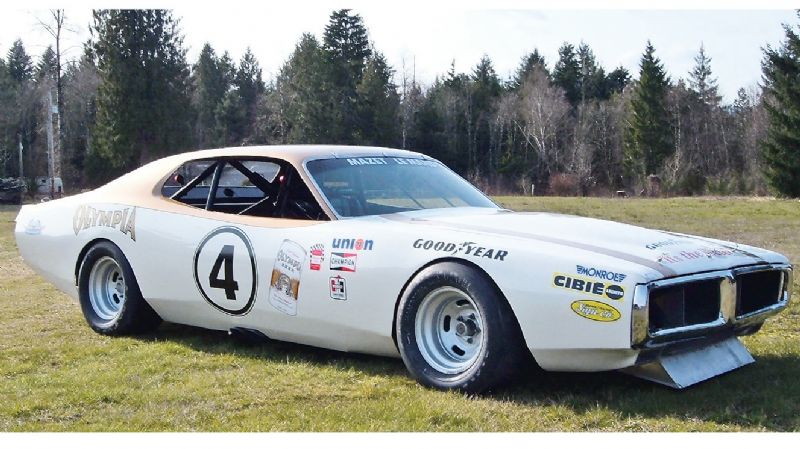NASCAR at Le Mans: When a Dodge Charger and Ford Torino Raced in Europe

They're going to run what? Where? For how long? This was likely a common reaction when it was announced that two full-figured NASCAR stockers were going to compete at the 24 Hours of Le Mans in 1976. Wasn't that a race in a faraway land called France, contested only by funny little furrin' cars? No, not since 1966, anyway, when Henry Ford II went there with his all-conquering GT program and the notion of trumping Enzo Ferrari at his own game. The result was the original four-peat: back-to-back factory wins in 1966 and 1967, plus two privateer victories by the Gulf-Wyer team in 1968 and 1969 (in the same car, no less). Sportsman/driver/car-builder Briggs Cunningham tried it a decade and a half before, with creditable results including a third overall. Goodness knows American iron has been there lately, rewriting the GT class record books courtesy of the factory-sponsored Viper GTS-R s from 1998 to 2000 and the Pratt & Miller Corvette team nearly every year since. A New Class for the NASCAR Boys: Grand International The story goes that Le Mans organizers were attempting to spice up their game. In mid-1975, they approached Bill France Sr. , doyen of NASCAR, about an exchange of classes between Le Mans and the 24 Hours of Daytona. France owned Daytona Speedway, and even then, what we now call the Rolex 24 was of international importance. Big Bill was in many ways the ultimate traditionalist and ran NASCAR with an iron fist. Yet he should be viewed as an innovator, too. Road racing was hardly new to NASCAR: Events held at natural road courses like Riverside and Watkins Glen had been a part of NASCAR's diet for years, although ovals wereand remainits staple. The product of this Franco-American negotiation was called the Grand International class, and its trial balloon was scheduled for Le Mans in June 1976. Two teams were selected by NASCAR: Owner/driver Herschel McGriff and son Doug would drive their Wedge-powered, Olympia Beer-sponsored Dodge Charger , and perennial privateer Junie Donlavey would bring a Ford Torino to be shared by Richard Brooks and Dick Hutcherson. NASCAR and the Le Mans race organizers paid the expenses for the teams and transportation. Don't for a minute think these good ol' boys were being served as gator bait to Europe's racing elite. Hutcherson had already been to Le Mans as a member of the previously mentioned Ford GT40 effort, finishing third overall in 1966 teamed with Ronnie Bucknum. Herschel McGriff was the most seasoned road racer among them. I'm guessing that's one of the reasons they chose our team to go to France, says the 78-year-old McGriff. I won the Carrera Panamericana in 1950 when was I only 22 years old, won 14 stock-car events at Riverside, and ran the 24 hours of Daytona. So they knew I was capable on a road course, because I wasn't just a circle-track guy. The French Love Les Deux Monstres The French media dubbed the Torino and the Charger Les Deux Monstres , the Two Monsters. But that wasn't out of fear or disdain; it was a term of endearment, one shared by the enthusiastic, international crowd. According to a period race report by Richmond News Leader sportswriter Randy Hallman, the cars and teams were swarmed. From the moment they arrived in France, the hulking Detroit beasts created a stir, fans flocked around the cars wherever they went. Indeed, they looked as out of place as if they'd been beamed down from some hovering starshipand got almost as much attention. According to Hallman, car-owner Donlavey said just prior to the start of the race, Everywhere we go, and I mean everywhere, there's a big crowd following us. They took our car and Herschel's on a parade through downtown Le Mansright through the main square. It was so crowded, people were pressed against the cars on both sides. Mirror, Mirror Considering what goes into a Le Mans effort these days, the preparations Donlavey and McGriff went through were minimal and straightforward. This car belonged to my son, says McGriff. We thought the Dodge would be a little bit slicker aerodynamically than the Chevelle I ran at Daytona. We had to add taillights, windshield wipers, lots of headlights, and radio gear. We ran lower-compression motors, but, otherwise, that was about it. It passed inspection with no problem, although in the driver's meeting, several of the guys who ran smaller, lower-riding prototypes asked that we install side mirrors so we could see them. That was the first thing that came up at the meeting. Put side mirrors on the big American cars!' Of course, we did. You know, we could go down the straightaway faster than anybody. It would go over 200 down the Mulsanne straight, blowing by those Porsches and all, but when I got to the 90-degree corner at the end of a run, I couldn't make it stop. And what of the rumor that McGriff brought 15 or so cases of Olympia's product labeled as lubricant? I think that's probably true, he notes with a snicker. Didn't drink much of it myself, but used to give a lot of it away when they were my sponsor. The McGriffs qualified toward the lower end of the grid, while the Brooks/Hutcherson Torino started from the 55th and last spot. Race Day: It's a Gas June 12, 1976, dawned bright and hot; the highs would be well into the 90s. Bill France Sr. was there, of course, and Bill France Jr. waved the starting flags. Unfortunately, NASCAR at Le Mans didn't live up to its advance billing and immense popularity. McGriff's engine blew on the second lap, thus the Olympia Dodge was the first car out of the race, officially shown as No Result. At Le Mans, you need to complete a certain number of laps even to be classified as a finisher. I was really disappointed in our performance. We made a big mistake, for which I guess I have to blame myself, on the octane of fuel that was available in France for the race. I thought the fuel was around 90 octane, and, of course, we were used to running 101 or 102. I passed this along to my engine man, and he built three lower-compression motors for the 90-grade stuff. But it turned out the real octane was more like 82 or 83, McGriff told us. Them big pistons just wouldn't take it, and we burned up the first two engines in practice. We added head gaskets to get the third engine to last, and NASCAR was trying to round up some higher-octane gas, but couldn't. We didn't do a good job of representing the class, and maybe that's why it didn't run a second year. If we'd have run the whole race, and finished, maybe it could've worked. The Donlavey Ford fared somewhat better, but finally gave up in the 11th hour. Le Mans is hell on transmissions; the NASCAR stocker's four-speeds were charged with approximately 22 gear changes per lap. There have been NASCAR contests where the driver never made 22 gear changes throughout the entire race. Hutcherson and Brooks also were unclassified. It was just a great experience, recalls McGriff. The most impressive thing was the sound. All the little Porsches sound like bumblebees, and then we'd roll by with those big-block V-8s running straight pipes and no mufflers. It shook the ground, and people loved it. Culture problems? Just one. When I go to Mexico, I can always use hand signals and can get by without the language. Can't do that with the French. I don't care how much you move your arms or legs, they don't understand what you want.Even though neither team was part of any victory celebration, McGriff recalls the scene well. I love the end of that race. People go crazy. They flood the grandstands. They drink. They have sex out on the grass. Vive la France, y'all. Epilogue Jacky Ickx and Gijs Van Lennep won the 44th running of the 24 Hours of Le Mans in a Porsche 936, completing 2963.39 miles at an average speed of 123.50 mph. Father and son McGriff are both alive and well, as is Donlavey. Herschel raced into his mid-1970s, finally retiring in 2002. In 1982, he made one more trip back to Le Mans with a prototype-class Camaro. His teammate? Truxmore Ford pilot Brooks. They had better luck this time, completing the race but again failing to amass enough miles to be classified a finisher. If they had, they would've ranked 19th overall. Dick Hutcherson passed away November 6, 2005. Richard Brooks died February 1, 2006. And what of NASCAR's desire to expand its involvement in road racing? The result, 30 years after this memorable effort in the French countryside that could've taken place only in the 1970s, is called the Grand American Road Racing series. An Epilogue to the Epilogue: Charger Rebrewed Thirty years after the McGriff's valiant, if not entirely successful attempt to run a NASCAR stocker at the world's most significant 24-hour endurance race, French/U.S.-car enthusiast Christophe Schwartz has constructed a recreation of the original Olympia Charger with backing from France, England, Switzerland, and the U.S. His co-driver will be Dick Pierson, an original member of the McGriff team. The goal is to run the car at this summer's Le Mans Classic vintage race. Schwartz's Big Bad Dodge, which is an accuratethough not identicalreplica of the McGriff original, is FIA-certified for vintage-car events. Herschel McGriff tells us he thought the engine was a 440 Wedge, but is confident it wasn't a 426 Hemi, as seen in the recreation. A 426 Wedge, perhaps, as several official documents indicate 7.0 liters? No matter: At the car's first test day at Portland International Raceway in late March, the Charger simply astounded. Christophe states: While being outbraked and outcornered by the small single-seaters, I had to lift on the straightaways in order not to push them off the track. Brakes are vintage Hurst/Airheart discs on all four corners, and they try hard to slow down the car's 3,800 pounds. The 426 Hemi's 700-plus horsepower reverberates inside the cockpit louder than you can imagine. The car looks and sounds stunning. Circulating PIR in its original Olympia livery, the reborn Charger caught the attention of everyone within eye- or earshot. For those attending the Le Mans Classic this summer, the French countryside will hear the rumble of 7.0 liters of classic NASCAR muscle for the first time in three decades. ATTENTION LE MANS FANS! MotorTrend is the EXCLUSIVE SPOT IN THE U.S. where viewers will be able to stream all of the 24 Hours of Le Mans, from qualifying to race end. Sign up for our special offer of only $2 a month for a year , and you'll get all of the action, including qualifying on Thursday, Sept. 17, live race coverage beginning at 7:30 a.m. ET (4:30 a.m. PT) on Sept. 19, and the checkered flag after 24 hours of on-track battle. In addition, fans will be able to view special content prior to and during the Le Mans weekendpart of a vast array of more than 3,200 hours of content available on the MotorTrend App. The post NASCAR at Le Mans: When a Dodge Charger and Ford Torino Raced in Europe appeared first on MotorTrend .
http://www.motortrend.com/news/c12-0606-nascar-goes-to-le-mans/




